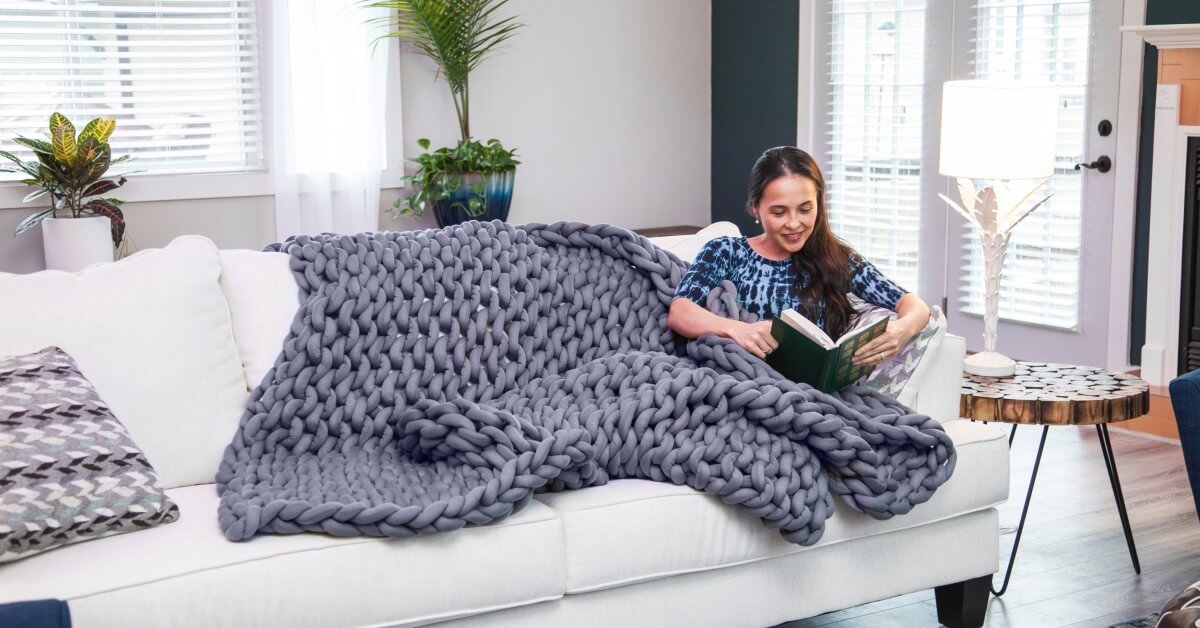Overview
Being held or hugged is one of those simple pleasures that can bring instant relief to someone experiencing discomfort.
The age-old practice of swaddling infants, for example, is still claimed by many to help little humans fall asleep faster and stay asleep longer, providing a protective, safe feeling that we appreciate far into our adult lives.
It would then stand to reason why the popularity of weighted blankets has soared in the past few years – especially with people experiencing insomnia.
The idea of something snugly holding you in bed certainly has a soothing allure for most of us, but do these heavy blankets help with real sleep problems?
Why are Weighted Blankets so Popular?
Insomnia is the inability to fall asleep and stay asleep or wake up too early. Unfortunately, the problem is rather prevalent in society, with up to a third of us not getting the sleep we need,[1] defined by the CDC as 7-9 hours of continuous sleep for adults.
For more than a third of people with insomnia, the sleep disorder is ongoing five years later.[2] And it cannot be resolved by passively giving it time. It has to be actively treated to improve sleep.
And although there are many methods of treatment for insomnia ranging from simply taking a melatonin tablet before bed to focusing on sleep hygiene and more, many people will still look for others as a new means of addressing their sleeplessness or something to complement their current efforts.
Do Weighted Blankets Help with Sleep?
In short, weighted blankets can help get your mind into a state of relaxation, allowing for easier falling and staying asleep. However, before you order a weighted blanket online or rush to your nearest retail store to buy one, please be aware that the benefits you can obtain from them have conditions.
Studies on the effectiveness of weighted blankets have shown positive results for cognitive conditions, such as ADHD and anxiety, which can indirectly help with sleep. Still, if your insomnia is rooted in a physical condition that is yet to be properly diagnosed or has deeper cognitive roots, it may not work for you.[3]
Therefore, as with any potential remedy for any condition, if your insomnia is ongoing for three months or more and you have tried first-line treatments without success, please consult your doctor to exclude any contributing health issues.
Tips for Choosing the Right Weighted Blanket for You
If you want to try a weighted blanket, here are some tips to help you find the right one.
- A blanket of around 10 percent of your body weight should work best as a rule of thumb.
- A weighted blanket should fit snugly to the size of your bed (otherwise, you might be losing sleep struggling with a heavy blanket as it slides around).
- If you have any breathing-related issues or sleep apnea, weighted blankets are not recommended due to their potential to add more pressure to your chest.
- People with claustrophobia may take longer to adjust to a weighted blanket or wish to avoid them altogether.
Conclusion
To fully grasp how prevalent insomnia is in our society, one needs only to look at the sheer variety of treatments available for this sleep disorder.
Drug store shelves are lined with all kinds of concoctions promising better sleep. The internet is flush with strategies and remedies around the topic; sometimes, the information can be confusing and downright harmful unless, like this site, it’s vetted by medical professionals.
Weighted blankets are one potential solution to get a good night’s rest, but remember that it may not work for everyone.
Suppose you still experience insomnia after trying home-based remedies, such as weighted blankets. In that case, it may be time to look into Cognitive Behavioral Therapy for Insomnia (CBT-I), the gold standard of treatment and the best solution to manage sleeplessness.
References:
- Roth T. (2007). Insomnia: definition, prevalence, etiology, and consequences. Journal of clinical sleep medicine : JCSM : official publication of the American Academy of Sleep Medicine, 3(5 Suppl), S7–S10.
- Morin, C. M., Jarrin, D. C., Ivers, H., Mérette, C., LeBlanc, M., & Savard, J. (2020). Incidence, Persistence, and Remission Rates of Insomnia Over 5 Years. JAMA network open, 3(11), e2018782. https://doi.org/10.1001/jamanetworkopen.2020.18782
- Eron, K., Kohnert, L., Watters, A., Logan, C., Weisner-Rose, M., & Mehler, P. S. (2020). Weighted Blanket Use: A Systematic Review. The American journal of occupational therapy: official publication of the American Occupational Therapy Association, 74(2), 7402205010p1–7402205010p14. https://doi.org/10.5014/ajot.2020.037358






